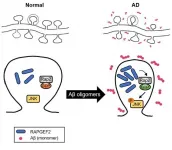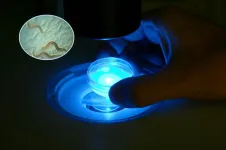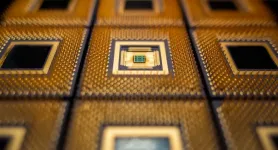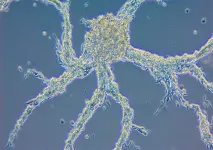INFORMATION:
Scientists suggested using 'defective' diamonds in x-ray optics
Scientists confirmed the applicability of nitrogen-bearing diamond crystals for the manufacture of X-ray optical devices
2021-02-24
(Press-News.org) X-rays are used to study the atomic and microstructure properties of matter. Such studies are conducted with special accelerator complexes called synchrotrons. A synchrotron source generates powerful electromagnetic radiation with a wavelength equal to fractions of a nanometer. Some X-rays are reflected from the atomic planes of a crystal and some go through the crystal plane that plays the role of a beam-splitter (or the so-called semitransparent mirror). If the radiation passes through monochromators-optical devices that consist of two or more ideal crystals - its optimal exit wavelength can be regulated. The parameters of electromagnetic radiation depend on the material that the optical element is made of. By improving the properties of optical devices one can increase the quality and efficiency of X-ray research methods and use modern scientific unique megascience facility to their full potential.
Most modern-day X-ray optical elements are based on silicon and germanium crystals. However, they get heated under the X-ray radiation from a synchrotron source, and high temperatures cause their crystal lattice to change leading to the distortion of the reflected beam. Optical elements made of artificial diamonds provide better beam quality, as their coefficient of thermal expansion and thermal conductivity are higher than in silicon elements. However, lab-grown diamonds contain not only carbon but also nitrogen. This inconsistency creates tension in the crystal and leads to uneven distances between the atoms. The cut of a crystal mainly depends on its internal structure, and the distribution of growth sectors (the areas that are formed when layers of substance grow on top of each other) correlates with the placement of nitrogen atoms. On the borders of these growth sectors, stress fields are formed. When a crystal is grown artificially, it is extremely difficult to control nitrogen level and distribution. Therefore, historically, the quality of plates made of nitrogen-bearing diamonds had been considered low for them to be used in optical elements. A team from BFU, together with their foreign colleagues, managed to disproof this belief and to obtain plates with sufficient defectless areas.
The team used BARS, a unique device for the manufacture of ultrahard materials, to grow two synthetic diamond crystals at 1,500°? and under the pressure of over 50 thousand atmospheres. The obtained crystals had almost perfect atomic grids. Then, small bits were chipped off from the crystals, and thin plates were made from them. First, their quality was assessed using X-ray examination, and after that, the plates were studied using the high-resolution diffractometry method on a synchrotron source. After scanning the plates, the team obtained high-resolution rocking curves--the charts that helped them evaluate the structural perfection of the crystals.
"The deflection angle of a crystal towards radiation changes depending on the energy of the incoming beam and the plane that it reflects from. This angle is called the Bragg angle. We incline a crystal at this angle, reflected radiation hits a detector, and then we start rocking it. The rocking curve that we get shows the correlation between the intensity of the reflected radiation and the deflection angle of the crystal. Then we compare the rocking curve with a pre-calculated theoretical curve of a perfect crystal," said Anatoly Snigirev, the head of the International Science and Research Center "Coherent X-ray Optics for Megascience facilities", BFU.
Having analyzed the charts, the team concluded, that although the crystal plates had many imperfections along the edges, there were large clear areas in their centers that accounted for over 50% of the total plate. Given that the defects usually become visible during the cutting and polishing of diamonds, the potential use of nitrogen-bearing diamonds in X-ray optics depends on improving these processes. Diamond crystals are needed for manufacturing of different optical elements, such as monochromators, beam-splitters, interferometers, and refractive lenses.
The study was carried out jointly with colleagues from the V.S. Sobolev Institute of Geology and Mineralogy SB RAS (Russia, Novosibirsk) and the German Electron Synchrotron DESY (Germany, Hamburg).
We are grateful to Nataliya Klimova, a scientific consultant and a junior researcher at the International Science and Research Center "Coherent X-ray Optics for Megascience facilities", BFU, for her assistance in preparing this article.
ELSE PRESS RELEASES FROM THIS DATE:
Data transfer system connects silicon chips with a hair's-width cable
2021-02-24
Researchers have developed a data transfer system that can transmit information 10 times faster than a USB. The new link pairs high-frequency silicon chips with a polymer cable as thin a strand of hair. The system may one day boost energy efficiency in data centers and lighten the loads of electronics-rich spacecraft.
The research was presented at this month's IEEE International Solid-State Circuits Conference. The lead author is Jack Holloway '03, MNG '04, who completed his PhD in MIT's Department of Electrical Engineering and Computer Science (EECS) last fall and currently works for Raytheon. Co-authors include Ruonan Han, associate professor and Holloway's PhD adviser in EECS, and Georgios Dogiamis, ...
Uncovers the molecular mechanism behind synapse loss in Alzheimer's disease
2021-02-24
Korea Brain Research Institute (KBRI, Pann-Ghill Suh (President)) announced that Dr. Kea Joo Lee and Dr. You-Na Jang of the Neural Circuits Research Group have identified the mechanism causing synaptic loss in Alzheimer's disease as the aberrant expression of RAPGEF2, a synaptic protein.
- The results were published on January 2021, in the online Early View of Neuropathology and Applied Neurobiology.
* (Title) RAPGEF2 mediates oligomeric Aβ-induced synaptic loss and cognitive dysfunction in the 3xTg-AD mouse model of Alzheimer's disease
Alzheimer's disease (AD) accounts for about 75% of dementia cases and is the most common type of degenerative brain disease. AD is a devastating because disease progression can cause ...
Celebrating Black chemists and chemical engineers
2021-02-24
Chemical & Engineering News (C&EN), the newsmagazine of the American Chemical Society (ACS), is celebrating Black chemists and chemical engineers with a special issue highlighting Black chemists who work across the fields of biotechnology, solar energy, pharmaceuticals and more. Guest edited by Massachusetts Institute of Technology (MIT) drug delivery pioneer Paula Hammond, Ph.D., this special issue showcases Black scientists, spotlighting their scientific passions and career accomplishments.
"In bringing into focus the unique lives of this set of accomplished Black scientists in chemistry and chemical engineering, ...
Study finds digital treatment for osteoarthritis is superior to traditional routine care
2021-02-24
The steadily increasing prevalence and high costs of treating chronic joint pain worldwide poses a challenge for healthcare systems and healthcare payers. New research published today in END ...
A gene provides both protection and destruction
2021-02-24
The family of ENDOU enzymes is found in most organisms, yet its functions are only poorly understood. In humans, it has been connected with cancer. RNA viruses, such as SARS-CoV2, contain a gene corresponding to ENDOU, and this is important for virus replication and the suppression of the immune response. However, so far only few details of the role of these enzymes are known. The research group led by the molecular geneticist Dr. Wenjing Qi from the University of Freiburg now contributes some more details to its function in a study published by the renowned scientific journal Nature Communications. They suggest that the gene ENDU-2 could ...
Pushing computing to the edge by rethinking microchips' design
2021-02-24
Responding to artificial intelligence's exploding demands on computer networks, Princeton University researchers in recent years have radically increased the speed and slashed the energy use of specialized AI systems. Now, the researchers have moved their innovation closer to widespread use by creating co-designed hardware and software that will allow designers to blend these new types of systems into their applications.
"Software is a critical part of enabling new hardware," said Naveen Verma, a professor of electrical and computer engineering at Princeton and a leader of the research team. "The ...
Flu vaccination this season likely to be highest ever
2021-02-24
More U.S. adults reported receiving or planning to receive an influenza vaccination during the 2020-2021 flu season than ever before, according to findings from a national survey.
The survey of 1,027 adults, conducted by the University of Georgia, found that 43.5% of respondents reported having already received a flu vaccination with an additional 13.5% stating they "definitely will get one" and 9.3% stating they "probably will get one." Combined, 66.3% have received or intend to receive an influenza vaccination.
By comparison, 48.4% of adults 18 and older received the vaccine during the 2019-2020 flu season, according to the Centers for Disease ...
'Micropopulism' may be turning education into a battlefield in the culture wars
2021-02-24
A new analysis of education debates on both social media and in traditional media outlets suggests that the education sector is being increasingly influenced by populism and the wider social media 'culture wars'.
The study also suggests that the type of populism in question is not quite the same as that used to explain large-scale political events, such as the UK's 'Brexit' from the European Union, or Donald Trump's recent presidency in the United States.
Instead, the researchers - from the University of Cambridge, UK, and Queensland University of Technology, Australia - identify a phenomenon called 'micropopulism': a localised populism which spotlights an aspect of public ...
Study finds low rate of COVID-19 among dental hygienists
2021-02-24
CHICAGO, February 24, 2021 -- Despite having been designated as high risk for COVID-19 by the Occupational Safety and Health Administration, a new study finds 3.1 percent of dental hygienists have had COVID-19 based on data collected in October 2020. This is in alignment with the cumulative infection prevalence rate among dentists and far below that of other health professionals in the U.S, although slightly higher than that of the general population.
The research, published by The Journal of Dental Hygiene, is the first large-scale collection and publication of U.S. dental hygienists' infection rates and infection control practices related to COVID-19. In partnership, the American Dental Hygienists' Association (ADHA) and the American Dental Association (ADA) ...
Sulfur: the consequences
2021-02-24
The transition from single-celled organisms to multicellular ones was a major step in the evolution of complex life forms. Multicellular organisms arose hundreds of millions of years ago, but the forces underlying this event remain mysterious. To investigate the origins of multicellularity, Erika Pearce's group at the MPI of Immunobiology and Epigenetics in Freiburg turned to the slime mold Dictyostelium discoideum, which can exist in both a unicellular and a multicellular state, lying on the cusp of this key evolutionary step. These dramatically different states depend on just one thing - food.
A core question of Pearce's lab is to answer how changes in metabolism drive cell function and differentiation. Usually, they study immune cells ...
LAST 30 PRESS RELEASES:
Young shark species more vulnerable to extinction
Mobile fetal heart monitoring linked to fewer newborn deaths in Tanzania
Bluey’s dad offered professorial chair in archaeology at Griffith University
Beyond small data limitations: Transfer learning-enabled framework for predicting mechanical properties of aluminum matrix composites
Unveiling non-thermal catalytic origin of direct current-promoted catalysis for energy-efficient transformation of greenhouse gases to valuable chemicals
Chronic breathlessness emerging as a hidden strain on hospitals
Paleontologists find first fossil bee nests made inside fossil bones
These fossils were the perfect home for ancient baby bees
Not everyone reads the room the same. A new study examines why.
New research identifies linked energy, immune and vascular changes in ME/CFS
Concurrent frailty + depression likely boost dementia risk in older people
Living in substandard housing linked to kids’ missed schooling and poor grades
Little awareness of medical + psychological complexities of steroid cream withdrawal
Eight in 10 trusts caring for emergency department patients in corridors, finds BMJ investigation
NASA’s Webb telescope finds bizarre atmosphere on a lemon-shaped exoplanet
The gut bacteria that put the brakes on weight gain in mice
Exploring how patients feel about AI transcription
Category ‘6’ tropical cyclone hot spots are growing
Video: Drivers struggle to multitask when using dashboard touch screens, study finds
SLU research shows surge in alcohol-related liver disease driving ‘deaths of despair’
Rising heat reshapes how microbes break down microplastics, new review finds
Roots reveal a hidden carbon pathway in maize plants
Membrane magic: FAMU-FSU researchers repurpose fuel cells membranes for new applications
UN Member States pledge to increase access to diagnosis and inhaled medicines for the 480 million people living with COPD
Combination therapy shows potential to treat pediatric brain cancer ATRT
Study links seabird nesting to shark turf wars in Hawai‘i
Legal sports betting linked to sharp increases in violent crime, study finds
Breakthrough AI from NYUAD speeds up discovery of life-supporting microbes
New Eva Mayr-Stihl Foundation funding initiative boosts research at University of Freiburg on adaptation of forests to global change
The perfect plastic? Plant-based, fully saltwater degradable, zero microplastics
[Press-News.org] Scientists suggested using 'defective' diamonds in x-ray opticsScientists confirmed the applicability of nitrogen-bearing diamond crystals for the manufacture of X-ray optical devices





